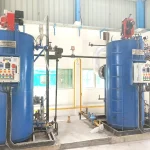PRESSURE REDUCING SYSTEM
PRESSURE REDUCING SYSTEM
As per the Indian Boiler Regulation, steam boiler manufacturers produce boilers above 10.54 kg/cm2 gauge pressure but the industrial requirement of the user may be less than that in those situations a PRS is used. It is an assembly of valves designed as per inlet and outlet pressure and flow as per customer’s requirements.
Pressure reducing systems produce dry saturated steam as they eliminate any condensate formed in the pipeline. Made with the highest level of safety measures, these systems are highly reliable. PRS also improves life of your machines by removing the carryover and drastically reduces corrosion of pipes and valves.


